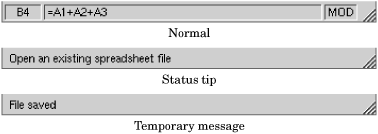Setting Up the Status Bar
With the menus and toolbars complete, we are ready to tackle the Spreadsheet application's status bar. In its normal state, the status bar contains three indicators: the current cell's location, the current cell's formula, and MOD. The status bar is also used to display status tips and other temporary messages.
The MainWindow constructor calls createStatusBar() to set up the status bar:
void MainWindow::createStatusBar()
{
locationLabel = new QLabel(" W999 ", this);
locationLabel->setAlignment(AlignHCenter);
locationLabel->setMinimumSize(locationLabel->sizeHint());
formulaLabel = new QLabel(this);
modLabel = new QLabel(tr(" MOD "), this);
modLabel->setAlignment(AlignHCenter);
modLabel->setMinimumSize(modLabel->sizeHint());
modLabel->clear();
statusBar()->addWidget(locationLabel);
statusBar()->addWidget(formulaLabel, 1);
statusBar()->addWidget(modLabel);
connect(spreadsheet, SIGNAL(currentChanged(int, int)),
this, SLOT(updateCellIndicators()));
connect(spreadsheet, SIGNAL(modified()),
this, SLOT(spreadsheetModified()));
updateCellIndicators();
}
The QMainWindow::statusBar() function returns a pointer to the status bar. (The status bar is created the first time statusBar() is called.) The status indicators are simply QLabels whose text we change whenever necessary. When constructing the QLabels, we pass this as the parent, but it doesn't really matter since QStatusBar::addWidget() automatically "reparents" them to make them children of the status bar.
Figure 3.13 shows that the three labels have different space requirements. The cell location and MOD indicators require very little space, and when the window is resized, any extra space should go to the cell formula indicator in the middle. This is achieved by specifying a stretch factor of 1 in its QStatusBar::addWidget() call. The other two indicators have the default stretch factor of 0, meaning that they prefer not to be stretched.
Figure 3.13. The Spreadsheet application's status bar

When QStatusBar lays out indicator widgets, it tries to respect each widget's ideal size as given by QWidget::sizeHint() and then stretches any stretchable widgets to fill the available space. A widget's ideal size is itself dependent on the widget's content and varies as we change the content. To avoid constant resizing of the location and MOD indicators, we set their minimum sizes to be wide enough to contain the largest possible text on each of the indicators ("W999" and "MOD"), with a little extra space. We also set their alignment to AlignHCenter to horizontally center their text.
Near the end of the function, we connect two of Spreadsheet's signals to two of MainWindow's slots: updateCellIndicators() and spreadsheetModified().
void MainWindow::updateCellIndicators()
{
locationLabel->setText(spreadsheet->currentLocation());
formulaLabel->setText(" " + spreadsheet->currentFormula());
}
The updateCellIndicator() slot updates the cell location and the cell formula indicators. It is called whenever the user moves the cell cursor to a new cell. The slot is also used as an ordinary function at the end of createStatusBar() to initialize the indicators. This is necessary because Spreadsheet doesn't emit a currentChanged() signal at startup.
void MainWindow::spreadsheetModified()
{
modLabel->setText(tr("MOD"));
modified = true;
updateCellIndicators();
}
The spreadsheetModified() slot updates all three indicators so that they reflect the current state of affairs, and sets the modified variable to true. (We used the modified variable when implementing the File menu to determine whether or not there were unsaved changes.)
Part I: Basic Qt
Getting Started
Creating Dialogs
- Creating Dialogs
- Subclassing QDialog
- Signals and Slots in Depth
- Rapid Dialog Design
- Shape-Changing Dialogs
- Dynamic Dialogs
- Built-in Widget and Dialog Classes
Creating Main Windows
- Creating Main Windows
- Subclassing QMainWindow
- Creating Menus and Toolbars
- Implementing the File Menu
- Setting Up the Status Bar
- Using Dialogs
- Storing Settings
- Multiple Documents
- Splash Screens
Implementing Application Functionality
- Implementing Application Functionality
- The Central Widget
- Subclassing QTable
- Loading and Saving
- Implementing the Edit Menu
- Implementing the Other Menus
- Subclassing QTableItem
Creating Custom Widgets
- Creating Custom Widgets
- Customizing Qt Widgets
- Subclassing QWidget
- Integrating Custom Widgets with Qt Designer
- Double Buffering
Part II: Intermediate Qt
Layout Management
- Layout Management
- Basic Layouts
- Splitters
- Widget Stacks
- Scroll Views
- Dock Windows
- Multiple Document Interface
Event Processing
- Event Processing
- Reimplementing Event Handlers
- Installing Event Filters
- Staying Responsive During Intensive Processing
2D and 3D Graphics
Drag and Drop
Input/Output
- Input/Output
- Reading and Writing Binary Data
- Reading and Writing Text
- Handling Files and Directories
- Inter-Process Communication
Container Classes
Databases
Networking
XML
Internationalization
- Internationalization
- Working with Unicode
- Making Applications Translation-Aware
- Dynamic Language Switching
- Translating Applications
Providing Online Help
- Providing Online Help
- Tooltips, Status Tips, and Whats This? Help
- Using QTextBrowser as a Simple Help Engine
- Using Qt Assistant for Powerful Online Help
Multithreading
- Multithreading
- Working with Threads
- Communicating with the GUI Thread
- Using Qts Classes in Non-GUI Threads
Platform-Specific Features
EAN: 2147483647
Pages: 140
